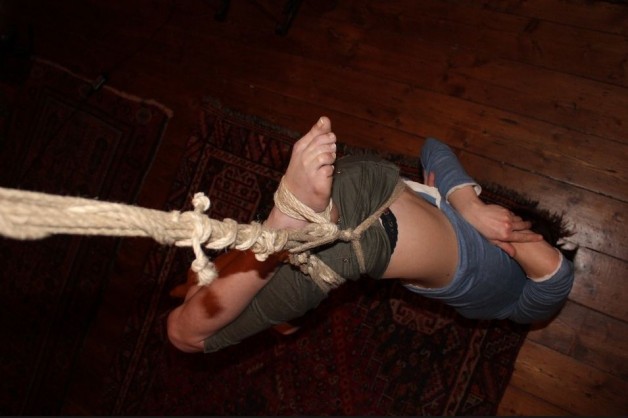The popularity of self-bondage seems to be on the rise. In addition to the usual fans, it seems to be augmented by a mixture of riggers testing ties and rigger-less bunnies having fun. A recent conversation about the model of a friend of mine, who was found dead after exhausting herself failing to release a self-imposed inverted suspension, reminded me of the dangers. A simple problem like loss of circulation can easily deprive one of the dexterity to release crucial ties or dropping a cutting implement out of reach can lead to disaster. Over the years, I have heard many anecdotes that could have ended as tragically had it not been for fate smiling on them, albeit wryly in some cases.
In one case, I heard of on the grapevine, a dropped handcuff key meant having to wait three days until the unfortunate victim’s brother dropped by and let himself in. It is just as much a problem if knots jam and rope snags. Escape attempts can be further hampered by numbness or loss of mobility to due to nerve damage or compromised circulation. A friend, who is quite well-known on the scene, had to be released from a botched self-suspension in her bedroom by her mother! If you can’t solve the problem, or are likely to exhaust yourself in the process, things can get very serious quickly. Panic and pain are likely to mean that you might not find an obvious solution. Many positions can become stress positions in short time and this risks fatal positional asphyxia, i.e. the stress causes the muscles you use to breath to become exhausted. Even excluding simple gags causing problems, e.g. choking from vomiting, or dangerous practices like erotic asphyxiation, there is an ever present danger of accidental asphyxiation. It is all too easy for a rope to slip, a fall or unconsciousness to cause a rope to end up around your neck. This page summarises a few tragedies. Some involve bizarre accidents like this one that included a lawn roller. Being famous is no help, as David Carradine, amongst others, discovered.
Of course, it makes sense to have some way of releasing safely yourself in an emergency. That means some form of safety cutter, which obviously needs to be accessible and impossible to lose. In more than one case, having some means of cutting yourself free has proved to be no guarantee of safety or even survival. In fact, it can even contribute to death!
Being alone is a common factor in the vast majority of bondage related deaths. Fatalities are pretty rare with a third party present. Without another person, there is no help if things go wrong and things can turn serious very fast. Don’t add to the statistics. If you must do it, do try to be aware of all the potential hazards, plan for those eventualities and then for when those contingencies go wrong! Sod’s Law dictates what can go wrong, will go wrong. Take that as a fact of life or it could become a fact of death. Be aware that, unless you are desperate for a Darwin Award, some things really should never be tried alone.

